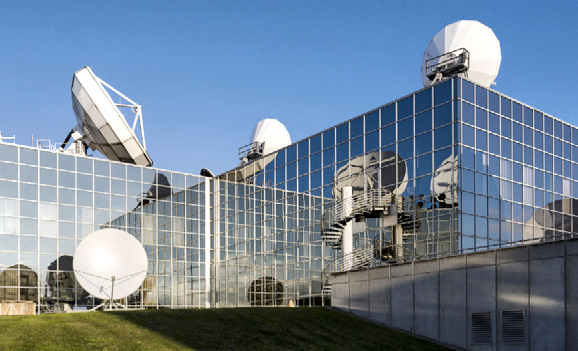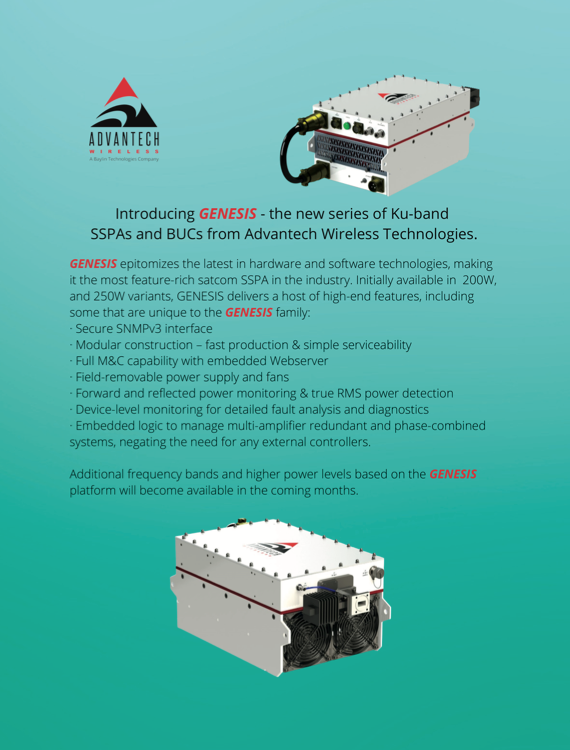The close of March heard the rumors of some form of relationship between SES of Luxembourg and Intelsat, also of Luxembourg. SES confirmed that discussions had and were taking place in regard to a “possible combination.” The usual boilerplate statement followed that stated there could be no certainty that a transaction would materialize.

The news — at this stage more rumor than hard fact — follows on from a slew of similar mergers/acquisitions in the sector that include Viasat ’s upcoming purchase of Inmarsat, as well as Eutelsat ’s ‘merger’ with OneWeb, and plenty of smaller, satellite-based deals over the recent years.
The hard facts are that any agreement between the two arch-rivals would position them in a better place to compete with new entrants, such as Starlink and the proposed Jeff Bezos-backed Project Kuiper.
Bloomberg, in its report on the rumor, stated that SES and Intelsat are in “advanced negotiations” and aiming to reach an agreement in the next few weeks. A satisfactory conclusion could value the combined business at more than $10 billion, including some debt.
“The market is highly fragmented in a sector where scale is critical,” Credit Suisse Group AG analysts — including Pilar Vico — wrote in a research note on March 29th., noting there are still about 55 operators across the globe. “The synergies could be considerable,.” he noted.
The reports seem well sourced and our own dialog seems to confirm the enthusiasm from SES for some sort of deal. However, the rumors about a merger between the pair are not new, as they initially surfaced last August.
Goldman Sachs in its note says that the duo control about 40 percent of the global market for fixed satellite capacity.
Intelsat’s Decline
Sami Kassab, an equity analyst at investment bank BNPP, said that the combined businesses might be valued on the basis of a $10 billion enterprise value. Given SES current Enterprise Value of 5 billion euros, this would suggest an Intelsat EV of about as much.
However, Kassab added, “We continue to be skeptical on the strategic merit of such a deal for SES but acknowledge the potential financial appeal of such a combination. On the strategic side, we believe that Intelsat has a weaker Video business (c35 percent of group revenues) than SES (more cable head-end feeding, Russia exposure). We also note that Intelsat balance sheet has prevented the company from investing in non-geostationary Networks and hence we believe Intelsat Networks (19 percent) is likely to see structurally declining revenues. In other words, more than half of Intelsat revenue is in structural decline. Government (19 percent) and Mobility (26 percent) offer better prospects as we believe Intelsat strategy is to move increasingly towards a distributor and system integrator role in Government and Mobility (ie acquisition of Gogo three years ago).
“On the other hand, this deal would offer financial appeal,” he stated in a note to clients. “For one, Intelsat is about to cash in $3.7 billion pre-tax from C-band payments by the end of this year. Secondly, the company has tax losses carried forward which we estimated at $3 billion in 2018 and which mostly sat in Luxembourg back then. Finally, such a deal would offer significant $200 million+ Opex savings as well as capex savings.
“Based on the 2021 issued Chapter 11 financial projections and assuming 5.5x net debt to EBITDA pre C-band and a 4x EV/EBITDA-23 multiple, we would value Intelsat equity at c$1.5billion before tax losses and synergies,” Kassab added. “While the financial side of the deal looks attractive, we are more skeptical about the strategic rationale and would expect the shares to be under pressure except if Intelsat’s valuation comes in particularly low.”

SES Headquarters
Unmentioned by Kassab is the major question of anti-trust sentiment, especially in the U.S. Europe has plenty of rival competition to SES (not least Eutelsat, Hispasat, Telenor, Arabsat, etc., etc.). This is not the case over North America, where the U.S. is dominated by Intelsat and SES (and Telesat over Canada).
Berenberg’s equity analyst Carl Murdock-Smith said, “Obviously much depends on the terms of any deal, but in principle, removal of excess capacity from the industry and the terms of any deal, but in principle, removal of excess capacity from the industry a synergy possibilities should be taken well. Intelsat came out of bankruptcy last year, with its reorganization reducing its debt from $16 billion to $7 billion. We believe that it has adjusted EBITDA of around $1 billion. Like SES, Intelsat is receiving a lot of C-band proceeds around the end of 2023. Intelsat will receive almost $3.7 billion from C-band Phase 2 (versus SES receiving $3 billion), which after tax, is likely to leave Intelsat’s leverage on 3-4x net debt/EBITDA. SES reported 2022 adjusted EBITDA of 1.1 billion euros, and €3.3 billion of net debt at the end of the year, plus €1.2 billion hybrids, so c4.5 billion euros fully loaded debt, which is 4x net debt/EBITDA (the adjusted figures that SES quotes only include half the hybrid). SES will receive C-band proceeds of $3 billion at the end of 2023/start of 2024, reducing fully loaded net debt at the end of 2024 to €1.9 billion, which is 1.7x net debt/EBITDA.”
The deal could not progress without the firm backing of the SES board of directors and, in particular, the three Luxembourg entities (which all own ‘B’ class shares) via the ‘State of Luxembourg’ and its 11.57 percent of SES shares, the Banque et Casse d’Epargne de l’Etat (10.88%), and the Société Nationale de Crédit et d’Investissement (SNCI) investment bank and its 10.88% stake.
The Regulators
However, there would inevitably be objections. The pair’s U.S. clients might complain about the risk of a near-monopoly supplier of fixed satellite services (FSS) over the U.S. The U.S. anti-trust authorities could be guaranteed to examine the deal quite closely and might order divestments.
Armand Musey, founder of Summit Ridge Group and a highly experienced observer of the satellite scene, said, “The biggest challenge may be anti-trust concerns, especially over North America. However, I’d expect many customers of both operators to weigh-in to oppose the deal out of concern for less competition. It may come down to whether regulators see new High Throughput Satellite (“HTS”) operators such as Hughes and Viasat, and LEO operators such as Starlink as sufficiently developed to be viable competition across Intelsat and SES’s customer segments. If not, it may require a divestiture of some satellite assets to get the deal done.”
Musey added, “The pending Viasat/Inmarsat merger increases industry consolidation and may create additional headwinds to getting an Intelsat/SES merger approved and which would cause further consolidation.”
Historically, it is worth remembering that both Intelsat and SES are relative ‘newcomers’ to the U.S. market. Intelsat achieved its U.S. position by acquiring PanAmSat for $3.2 billion in 2005, while SES had moved earlier into the US market by absorbing GE Americom for around $5 billion in 2001.

Intelsat Headquarters
The Luxembourg Connection
Helping a deal might be the Luxembourg connections. SES operates from Luxembourg. Intelsat is officially domiciled in Luxembourg. Intelsat’s owner is Munich-based insurance and asset management business Allianz SE which formalized their control over Intelsat Holdings SA in January of 2022, following Intelsat’s exit from bankruptcy.
Allianz financed Intelsat’s exit by paying some $7.875 billion for the business. However, the financing structure is extremely complex and not helped by the assorted Intelsat sister companies. For example, the new structure of Intelsat License LLC., based in Luxembourg, has at its core PIMCO (Pacific Investment Management Company LLC), a Delaware limited liability company that serves as the manager or investment adviser for a number of investment funds and other investment vehicles that each will hold (post- emergence) less than 10 percent voting and non-voting equity interests in New Intelsat.
The aggregate total of the voting and non-voting equity interests in New Intelsat by the PIMCO-managed funds will be approximately 32.8 percent. Allianz Asset Management of America L.P., a Delaware limited partnership, holds 79.1 per cent of the non-voting equity interest and 100 per cent of the voting equity interest in PIMCO, according to Intelsat.
In other words, the New Intelsat shareholders of Intelsat License LLC were, in essence, comprised of various Allianz controlled entities that included PIMCO, Allianz Asset Management of America LLC, Allianz Asset Management of America LP, Munich-based Allianz Asset Management GmbH, Allianz SE, Allianz Asset Management of America Holdings, Inc., Allianz of America, Inc., and Netherlands-based Allianz Europe BV.
Examining the hundreds of Allianz subsidiaries requires a substantial number of forensic accountants! The assets are huge and are complex to investigate. Anyone needing proof of that statement should look at Allianz SE’s annual report for 2022 (and, in particular, Pages 95-102 out of the 138-page report).
Clearly, Allianz will be seeking a return on its investment, but the prospects for some sort of merger/joint-venture between New Intelsat and SES is a clear option.
Additionally, any link would usefully bring an end to the (seemingly) never-ending litigation between the two players over C-band payments and how the FCC divides up the overall compensation payments.
Mergers & Acquisitions are fraught with risks: of the talks breaking down; of would-be partners falling out. Then there’s the implementation of the marriage. As always, it is the partners falling out. The lawyers who really win!

Author Chris Forrester is a well-known broadcasting journalist, industry consultant and Senior Columnist for SatNews Publishers. He reports on all aspects of broadcasting with special emphasis on content, the business of television and emerging applications. He founded Rapid TV News and has edited Interspace and its successor Inside Satellite TV since 1996. He also files for Advanced-Television.com. In November of 1998, Chris was appointed an Associate (professor) of the prestigious Adham Center for Television Journalism, part of the American University in Cairo (AUC), in recognition of his ive coverage of the Arab media market.
Intelsat inside trading Action: “Core deficiencies remain”
The long-running Class Action against alleged Intelsat inside traders has seen a rebuttal submitted by the Defendants, and filed on March 30th. They argue that the Plaintiffs have failed to make their case and has not made any plausible facts demonstrating that Intelsat obtained any material, non-public information, prior to the Defendants [sale of shares]. The rebuttal calls for the court to dismiss the Action.
The events that lead up to the claim state that on the morning of November 5, 2019, a meeting took place with Intelsat’s CEO Steve Spengler at the FCC to discuss Intelsat’s (and SES) C-band proposal for a private auction of some of the satellite company’s C-band assets over the U.S.
The Plaintiff’s Class Action cites precedence and states, “Indeed, investors do not expect the playing field to be level, but they do expect that those who ‘have special access to information, because of employment or other relationships, should be barred from using that information to gain an advantage over the rest of us.”
The Plaintiffs added, “This is the quintessential insider trading case,” the lawsuit says. “Intelsat, a satellite operator, was successfully pursuing a bet-the-company-deal with the FCC. Its board chairman, defendant David McGlade, and its two largest shareholders, defendants BC Partners and Silver Lake, sold $246 million in stock, the very same day they learned the FCC was turning against the deal.”
The rebuttal filed to the court states, “Plaintiff’s claims against BC Partners [one of the key players in the Class Action claim] are only viable if it can plead
(i) that Intelsat learned material non-public information during a November 5, 2019, meeting about the FCC’s controversial pending decision on whether to conduct a public or private auction of C-Band spectrum;
(ii) that Intelsat then passed that information to BC Partners in the scant hours between the meeting and BC Partners’ trade; and
(iii) that the inference that BC Partners traded while in possession of material non-public information is at least as compelling as the inference that, in light of persistent and high-profile opposition to a private auction, BC Partners was already planning to reduce its stake in Intelsat once a trading window opened after Intelsat’s earnings announcement.
“Plaintiff does not plead any of these necessary elements of its claims, let alone all of them,” said the rebuttal.
The Defendants’ 18-page document to the court states that the Plaintiffs in the case offer documents that offer nothing more than management’s subjective assessment of the political environment and risk surrounding the FCC’s decision at that time.
The Plaintiffs, in their March 5th filing, argued that “Any reasonable person – and juror – would believe that there was insider trading.”
The Action argues that the defendants in the case sold shares worth $246 million and thus avoided $185 million in losses but “innocent investors were left [with nothing].” The Action states each of the named defendants “owed a fiduciary duty to Intelsat shareholders.”
The Action is due to be heard on April 28th., no doubt depending on whether a merger is announced between SES and Intelsat before then. The Action is due to be heard on April 28th., no doubt depending on whether a merger is announced between SES and Intelsat before then.


